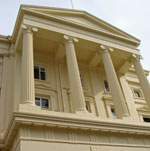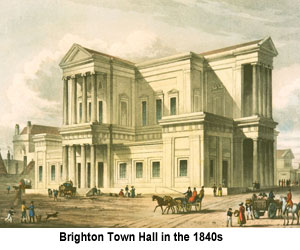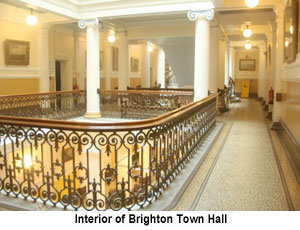
Brighton Town Hall's classical facade

FRONT PAGE
Site Search
About us
  

City Halls: Europe
| Aachen | Antwerp | Athens | Berlin | Birmingham | Bolton | Bradford | Bremen | Brighton | Cardiff | Cologne | Cork | Dresden | Florence | Glasgow | Hanover | Innsbruck | Jena | Leeds | Liverpool | London | Manchester | Moscow | Munich | Neuss | Paris | Sheffield | Southampton | Stockholm | Stuttgart | The Hague | Vienna |
City Halls: The Americas
| Bogota | Boston | Buenos Aires | Chicago | Houston | New York | Philadelphia | Pittsburgh | San Francisco | Seattle | Toronto | Vancouver |
City Halls: Asia + Australasia
| Ekaterinburg | Sydney | Tokyo | Wellington |

Worldwide | Elections | North America | Latin America | Europe | Asia | Africa |



























|
|
Brighton Town Hall
By Richard Price
8 October 2013: Thanks to its close proximity to London and Royal patronage throughout the 19th Century, Brighton, on the English South Coast, has developed like no other seaside resort in Britain. While towns like Eastbourne, Bournemouth or Torquay predominately cater for holidaymakers and have become favourite destinations for retirees, Brighton has developed a youth vibrancy to rival the British capital. Often described as London-on-Sea, Brighton also offers some of the finest Regency and Victorian terraces in Britain. The Town Hall, built in the 1830s, is an example of municipal pride and confidence.
• History of Brighton
• The Town Hall
• Politics
History of Brighton
While Brighton became one of Britain’s most fashionable seaside resorts during the 19th Century, its origins go back to the Middle Ages. The Domesday Book of 1086 mentions a settlement made up of three manors on today’s site of Brighton. One of the manors carried the name Bristelmestune. The architectural historian Nikolaus Pevsner described the 12th-century font of Brighton’s former parish church as the best piece of Norman carving in Sussex. During the early part of the 16th Century the Sussex village of Brighthelmstone was mentioned in several documents and by the middle of the 17th Century Brighthelmstone was, with a population of more than 4,000, the largest town in the county.
It was during the first half of the 18th Century that a number of doctors and medical practitioners advocated the drinking of seawater and sea bathing. This increased interest in the use of the local mineral waters for drinking and bathing and in 1769 the foundation stone for the Brighton Baths was laid. In September 1783, the then Prince of Wales, who later became Prince Regent and, following the death of his mentally ill father, King George IV, visited Brighton for the first time. His love affair with the town was to last for some 40 years. He commissioned the building of the Royal Pavilion palace, Brighton’s iconic landmark.
Brighton's popularity with Britain’s high society and members of the Royal family continued throughout the 19th century, although Queen Victoria disliked the town, particularly after it became easy to reach by ordinary Londoners following the opening of Brighton railway station in 1841.
 Brighton Town Hall Brighton Town Hall
By the 1760s many English towns established Commissioners by private Acts of Parliament. Sixty-four Brighton residents were named in a petition for the Act. Commissioners were responsible for streets and markets. An 1825 Act of parliament authorised the Brighton Commissioners to build a new market and Town Hall. A resolution was passed and it was to include a few prison cells with rooms for public meetings.
A public competition for the tender for the design was announced. There were several contenders, at a full meeting of the Commissioners and by ballot the winner, Thomas Cooper was awarded the premium of £50.
He was a Commissioner whose father was a local builder who had been killed in 1826 during a fall from a house under construction in Brunswick Square. He had already designed a chapel in Church Street for George Faithful (1826) and The Bedford Hotel (1829).
The foundation stone was laid in 1830 and the building was finished by 1832. It was supposed to be built as a Greek cross. The Commissioners were unable to purchase the land for the South wing so it ended up shaped like the letter T.
The large room in the building was made available for public and private events. Free use could be afforded by the Commissioners but there was no clear definition of what constituted the free use. In 1837 the Commissioners agreed that it should be free for the Vestry and town meetings and in 1839 they decided it should be free for everyone but withdrew this in 1847 and introduced a scale of charges.
In the 18th century, architects often copied designs from the 1762 Antiquities of Athens by James Stuart and Nicholas Revett. Public buildings such as town halls imparted a monumental air and linked British and ancient Grecian politics thus associating the activities within these buildings with dignity and grandeur.
Brighton Town Hall is a striking but unorthodox building, which consists of three of the five orders of classical architecture - Doric, Ionic and Corinthian. The two entrances on the North façade and East facades are imposing. Each has eight columns; one set of four at ground level, the other set upon it at first floor level. The lower level forms a tetrastyle portico. The north façade has steps leading up through it to the entrance. The east façade at ground level has Doric columns while the second storey columns are Ionic.
The entrance on the east façade is via an oak hallway. Greek architecture was a mathematically based art. Ratios and proportions were applied to ground plans and elevations with the aim of achieving perfection and symmetry. The interior of the building achieves this aim. It consists of Corinthian pillars, which surround a central staircase with a finely crafted metalwork banister and a Georgian glass ceiling. The floor mosaic was laid by Italian craftsman and relaid in 1899 using the original mosaic blocks. The shield of arms central to the mosaic (two dolphins within a blue shield) translates from Latin into “In God We Trust”, which is the old Brighton Corporation motto.
Brighton’s Town Hall is a Grade 1 listed building, which means it is government protected. It is no longer the seat of local government. Since the merger of the town with neighbouring Hove, all council business is conducted from two sites in Hove. Brighton Town Hall meanwhile acts as a museum and venue for social occasions such as weddings.
 Politics Politics
Brighton and Hove is, with a population of more than 270,000, Britain’s largest seaside resort. Following the amalgamation of Brighton with the neighbouring town of Hove in 1997, the town was granted city status as part of the millennium celebrations in 2000. Since its incorporation as a municipal borough in 1854, Brighton expanded eastwards and northwards by absorbing villages such as Rottingdean, Patcham and Ovingdean. Meanwhile, Hove grew westwards by taking over the village of Portslade.
Brighton and Hove is the only council in Britain where the Greens are the strongest party and lead the City Council. At the 2010 General Election, Brighton became the first and only constituency in the UK to elect a Green Member of Parliament.
Brighton is often referred to as the UK’s gay capital. The 2001 census data showed that Brighton had the highest proportion of same sex households in Britain. With same-sex marriages allowed being allowed in England and Wales since July 2013, Brighton hopes to become the gay marriage capital of Europe. The 2011 census already showed Brighton to have had the highest number of civil partnerships in the country.
|
|

|





































